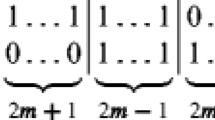Abstract
A binary nonlinear code can be represented as a union of cosets of a binary linear subcode. In this paper, the complexity of some algorithms to obtain this representation is analyzed. Moreover, some properties and constructions of new codes from given ones in terms of this representation are described. Algorithms to compute the minimum distance of binary nonlinear codes, based on known algorithms for linear codes, are also established, along with an algorithm to decode such codes. All results are written in such a way that they can be easily transformed into algorithms, and the performance of these algorithms is evaluated.









Similar content being viewed by others
References
Bauer H., Ganter B., Hergert F.: Algebraic techniques for nonlinear codes. Combinatorica 3, 21–33 (1983).
Betten A., Braun M., Fripertinger H., Kerber A., Kohnert A., Wassermann A.: Error-Correcting Linear Codes: Classification by Isometry and Applications. Springer, Berlin (2006).
Borges J., Fernández C.: Plotkin construction: rank and kernel, pp. 1–3. arXiv:0707.3878v1 (July 26, 2007).
Borges J., Fernández C., Pujol J., Rifà J., Villanueva M.: \({\mathbb{Z}}_{2}{\mathbb{Z}}_{4} \)-linear codes: generator matrices and duality. Des. Codes Cryptogr. 54(2), 167–179 (2010).
Borges-Qintana M., Borges-Trenard M. A., Márquez-Corbella I., Martínez-Moro E.: Computing coset leaders and leader codewords of binary codes. J. Algebra Appl. (2014)
Bouyukliev I., Bakoev V.: A method for efficiently computing the number of codewords of fixed weights in linear codes. Discret. Appl. Math. 156(15), 2986–3004 (2008).
Cannon J.J., Bosma W. (eds.).: Handbook of Magma Functions, 2.13 edn, p. 4350. http://magma.maths.usyd.edu.au/magma/ (2006).
Canteaut A., Chabaud F.: A new algorithm for finding minimum-weight words in a linear code: application to McEliece’s cryptosystem and to narrow-sense BCH codes of length 511. IEEE Trans. Inf. Theory 44(1), 367–378 (1998).
Elssel K., Zimmermann K.-H.: Two new nonlinear binary codes. IEEE Trans. Inf. Theory 51(3), 1189–1190 (2005).
Grassl M.: Searching for linear codes with large minimum distance. In: Bosma W., Cannon J. (eds.) Discovering Mathematics with Magma. Springer, Berlin (2006).
Guerrini E., Orsini E., Sala M.: Computing the distance distribution of systematic non-linear codes. J. Algebra Appl. 9(2), 241–256 (2010).
Hammons A.R., Kumar P.V., Calderbank A.R., Sloane N.J.A., Solé P.: The \({\mathbb{Z}}_4\)-linearity of kerdock, preparata, goethals and related codes. IEEE Trans. Inf. Theory 40(2), 301–319 (1994).
Heden O.: On perfect \(p\)-ary codes of length \(p+1\). Des. Codes Cryptogr. 46(1), 45–56 (2008).
Huffman W.C., Pless V.: Fundamentals of Error-Correcting Codes. Cambridge University Press, Cambridge, MA (2003).
Lisoněk P., Trummer L.: An extension of the Brouwer–Zimmermann minimum weight algorithm. Presented at the 4th International Castle Meeting on Coding Theory and Applications, Palmela, Portugal, 15–18, Sept, 2014.
MacWilliams F.J., Sloane N.J.A.: The Theory of Error-Correcting Codes. North-Holland, Amsterdam (1977).
Mohri M., Morii M.: On computing the minimum distance of linear codes. Electron. Commun. Jpn. 3 83(11), 32–42, (2000).
Östergård P.R.J.: Two new four-error-correcting binary codes. Des. Codes Cryptogr. 36(3), 327–329 (2005).
Östergård P.R.J., Pottonen O.: The perfect binary one-error-correcting codes of length 15: part I—classification. IEEE Trans. Inf. Theory 55(10), 4657–4660 (2009).
Östergård P.R.J., Pottonen O., Phelps K.T.: The perfect binary one-error-correcting codes of length 15: part II properties. IEEE Trans. Inf. Theory 56(6), 2571–2582 (2010).
Phelps K.T., Rifà J., Villanueva M.: Kernels and \(p\)-kernels of \(p^r\)-ary 1-perfect codes. Des. Codes Cryptogr. 37(2), 243–261 (2001).
Pujol J., Zeng F., Villanueva M.: Representation, constructions and minimum distance computation of binary nonlinear codes. In: Proceedings in Aplications of Computer Algebra, Málaga, Spain, pp. 142–143 (2013).
Vardy A.: The intractability of computing the minimum distance of a code. IEEE Trans. Inf. Theory 43(6), 1757–1773 (1997).
White, G.: Enumeration-based algorithms in coding theory. PhD Thesis, University of Sydney, (2006).
White G., Grassl M.: A new minimum weight algorithm for additive codes. In: ISIT 2006, Seattle, WA, vol. 9(14), pp. 1119–1123, July, 2006.
Zimmermann K.-H.: Integral hecke modules, integral generalized Reed–Muller codes, and linear codes. Tech. Rep. 3–96, Technische Universität Hamburg-Harburg (1996).
Acknowledgments
This work has been partially supported by the Spanish MICINN under Grants TIN2010-17358 and TIN2013-40524-P, and by the Catalan AGAUR under Grant 2014SGR-691. The material in this paper was presented in part at the Applications of Computer Algebra Conference, Málaga, Spain 2013 [22].
Author information
Authors and Affiliations
Corresponding author
Additional information
This is one of several papers published in Designs, Codes and Cryptography comprising the “Special Issue on Computer Algebra in Coding Theory and Cryptography”.
Rights and permissions
About this article
Cite this article
Villanueva, M., Zeng, F. & Pujol, J. Efficient representation of binary nonlinear codes: constructions and minimum distance computation. Des. Codes Cryptogr. 76, 3–21 (2015). https://doi.org/10.1007/s10623-014-0028-4
Received:
Revised:
Accepted:
Published:
Issue Date:
DOI: https://doi.org/10.1007/s10623-014-0028-4



